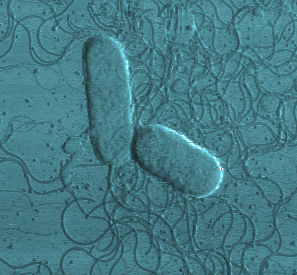Discovery of a new light-powered sodium pump New rhodopsin family revealed among marine bacteria

Researchers at the University of Tokyo’s Atmosphere and Ocean Research Institute (AORI) found a novel light-driven sodium pumping rhodopsin (NaR) in a marine bacterium, Krokinobacter eikastus. Dr. S. Yoshizawa and Prof. K. Kogure at the AORI Center for Earth Surface System Dynamics discovered the new pump working in collaboration with rhodopsin specialists Dr. K. Inoue and Prof. H. Kandori at the Department of Frontier Materials, Nagoya Institute of Technology.
The light-driven proton pump Proteorhodopsin was discovered in marine bacteria in 2000, which is now known to be distributed among half of the bacteria living in the surface layer of marine environments. In this latest research, the group showed that Krokinobacter eikastus possesses two rhodopsins, KR1 and KR2. KR1 is a proton pump, which pumps protons out of the cells under light, whereas KR2 transfers sodium ions. The sodium gradient thus established across the membrane provides energy for various biological functions such as the active transport of other compounds across the cell membrane.
In general all living organisms on the planet maintain low sodium concentration in the cell by a variety of mechanisms, all of which require energy, but so far none has been known to use light energy. Another novelty is that NaR belongs to the rhodopsin family. Rhodopsins are a protein family widely spread among animals, algae, and bacteria. For example, visual purple in the human eye is a sensory type rhodopsin. Among microorganisms, the existence of proton pumps and chloride pumps is well known, but there has been no report of a sodium pump.
Because sodium is a fundamental element in all living organisms, this finding raises many questions, including the advantage of NaR for establishing a sodium gradient and its origin and evolution. In addition, from an oceanographic perspective, it raises many ecological questions, such as how widespread NaR is in marine environments and how much light energy passes through NaR to the ocean. This finding elicits numerous questions and requires a reevaluation of traditional views on sodium metabolism in living organisms. This newly found sodium pump may also have applications if introduced into organisms living in salty environments, enabling them to grow or survive in high-salt environments if enough light is available.
Paper
Keiichi Inoue, Hikaru Ono, Rei Abe-Yoshizumi, Susumu Yoshizawa, Hiroyasu Ito, Kazuhiro Kogure, Hideki Kandori,
“A light-driven sodium ion pump in marine bacteria”,
Nature Communications Online Edition: 2013/04/10(Japan time), doi: 10.1038/ncomms2689.
Article link
Links
Atmosphere and Ocean Research Institute
Center for Earth Surface System Dynamics (Japanese)







